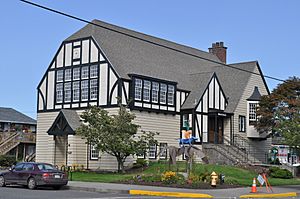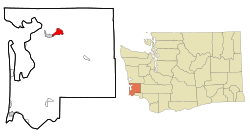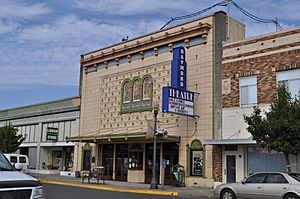Raymond, Washington facts for kids
Quick facts for kids
Raymond
|
|
|---|---|
| Raymond, Washington | |

Raymond Timberland Library
|
|

Location of Raymond, Washington
|
|
| Country | United States |
| State | Washington |
| County | Pacific |
| Area | |
| • Total | 4.69 sq mi (12.14 km2) |
| • Land | 4.09 sq mi (10.59 km2) |
| • Water | 0.60 sq mi (1.55 km2) |
| Elevation | 13 ft (4 m) |
| Population
(2020)
|
|
| • Total | 3,081 |
| • Density | 656.9/sq mi (253.79/km2) |
| Time zone | UTC-8 (Pacific (PST)) |
| • Summer (DST) | UTC-7 (PDT) |
| ZIP code |
98577
|
| Area code(s) | 360 |
| FIPS code | 53-57430 |
| GNIS feature ID | 1507743 |
| Website | City of Raymond |
Raymond is a city in Pacific County, Washington, United States. In 2010, about 2,882 people lived there. By 2020, the population grew to 3,081. This was an increase of 6.4%. For a long time, the city's main jobs were in logging (cutting down trees) and fishing. There is also a small amount of tourism.
Contents
History of Raymond
Raymond became an official city on August 6, 1907. It was named after L.V. Raymond, who was the first postmaster in the area. In its early days, many businesses in Raymond were built on tall stilts. These stilts kept the buildings above the wet tidelands and water channels. Raised sidewalks and streets connected most of the buildings.
In 1913, Raymond had about 6,000 people. It was known as a busy lumber mill town. City leaders tried to change this image. They promoted Raymond as "The Empire City of Willapa Harbor" and "The City That Does Things."
A famous songwriter, Robert Wells, was born in Raymond in 1922. He helped write the well-known song "The Christmas Song." The famous grunge band Nirvana played their very first concert in Raymond. This happened on March 7, 1987.
Geography of Raymond

Raymond is located at 46°40′47″N 123°44′17″W / 46.67972°N 123.73806°W. This means it is at 46.679599 degrees North and -123.738091 degrees West.
The city covers a total area of about 4.62 square miles (12.0 square kilometers). Most of this area, about 4.06 square miles (10.5 square kilometers), is land. The rest, about 0.56 square miles (1.5 square kilometers), is water.
Climate in Raymond
Raymond has a climate known as a warm-summer Mediterranean climate. This type of climate is often called "Csb" on climate maps. It means the summers are warm and dry, and the winters are mild and wet.
| Climate data for Raymond | |||||||||||||
|---|---|---|---|---|---|---|---|---|---|---|---|---|---|
| Month | Jan | Feb | Mar | Apr | May | Jun | Jul | Aug | Sep | Oct | Nov | Dec | Year |
| Record high °F (°C) | 65 (18) |
75 (24) |
79 (26) |
86 (30) |
94 (34) |
97 (36) |
100 (38) |
102 (39) |
99 (37) |
88 (31) |
69 (21) |
63 (17) |
102 (39) |
| Mean daily maximum °F (°C) | 47.5 (8.6) |
50.4 (10.2) |
54 (12) |
57.9 (14.4) |
62.5 (16.9) |
66.1 (18.9) |
70.8 (21.6) |
72.3 (22.4) |
70 (21) |
60.7 (15.9) |
51.5 (10.8) |
46.1 (7.8) |
59.1 (15.1) |
| Mean daily minimum °F (°C) | 33.1 (0.6) |
32.6 (0.3) |
35.2 (1.8) |
37.5 (3.1) |
42.6 (5.9) |
47.1 (8.4) |
50.5 (10.3) |
50 (10) |
45.3 (7.4) |
39.6 (4.2) |
35.8 (2.1) |
32.3 (0.2) |
40.1 (4.5) |
| Record low °F (°C) | 5 (−15) |
5 (−15) |
20 (−7) |
24 (−4) |
28 (−2) |
34 (1) |
37 (3) |
35 (2) |
29 (−2) |
17 (−8) |
9 (−13) |
3 (−16) |
3 (−16) |
| Average precipitation inches (mm) | 12.58 (320) |
9.2 (230) |
9.67 (246) |
6.48 (165) |
3.95 (100) |
2.88 (73) |
1.25 (32) |
1.33 (34) |
2.69 (68) |
7.37 (187) |
13.73 (349) |
12 (300) |
83.13 (2,112) |
| Average snowfall inches (cm) | 0.5 (1.3) |
0 (0) |
0 (0) |
0 (0) |
0 (0) |
0 (0) |
0 (0) |
0 (0) |
0 (0) |
0 (0) |
0.1 (0.25) |
0.3 (0.76) |
1 (2.5) |
| Average precipitation days (≥ 0.01 inch) | 22 | 18 | 22 | 20 | 17 | 14 | 8 | 8 | 10 | 18 | 23 | 21 | 201 |
People of Raymond (Demographics)
| Historical population | |||
|---|---|---|---|
| Census | Pop. | %± | |
| 1910 | 2,450 | — | |
| 1920 | 4,260 | 73.9% | |
| 1930 | 3,828 | −10.1% | |
| 1940 | 4,045 | 5.7% | |
| 1950 | 4,110 | 1.6% | |
| 1960 | 3,301 | −19.7% | |
| 1970 | 3,126 | −5.3% | |
| 1980 | 2,991 | −4.3% | |
| 1990 | 2,901 | −3.0% | |
| 2000 | 2,975 | 2.6% | |
| 2010 | 2,882 | −3.1% | |
| 2020 | 3,081 | 6.9% | |
| U.S. Decennial Census 2020 Census |
|||
Raymond's Population in 2010
In 2010, there were 2,882 people living in Raymond. These people lived in 1,151 homes, and 698 of these were families. The city had about 709.9 people per square mile. There were 1,279 housing units, which are places where people can live.
The people living in Raymond came from different backgrounds:
- 75.9% were White
- 0.9% were African American
- 2.5% were Native American
- 6.8% were Asian
- 10.1% were from other races
- 3.9% were from two or more races
- 16.2% were Hispanic or Latino (of any race)
Out of the 1,151 homes:
- 29.4% had children under 18 living there.
- 42.9% were married couples living together.
- 10.4% had a female head of the house with no husband.
- 7.3% had a male head of the house with no wife.
- 39.4% were not families (like single people living alone).
About 33.4% of homes had only one person. And 15.2% of homes had one person who was 65 or older. On average, there were 2.46 people in each home and 3.10 people in each family.
The average age of people in Raymond was 41 years old.
- 23.4% of people were under 18.
- 8.6% were between 18 and 24.
- 22.2% were between 25 and 44.
- 27.5% were between 45 and 64.
- 18.4% were 65 or older.
The city had almost an equal number of males and females: 49.9% male and 50.1% female.
Arts and Culture in Raymond
Historic Buildings and Places

The city is home to the Raymond Theatre. This theater was built in 1928. It was added to the National Register of Historic Places in 1991. This means it is a very important historic building.
The Willapa River Swing Bridge, also called the Raymond Trestle, is in the middle of the city. People have thought about fixing up this bridge. They want to add it to the Willapa Hills Trail for people to use.
Museums to Visit
Raymond has some interesting museums:
- The Northwest Carriage Museum has a collection of old carriages, buggies, and sleighs. It even has a special carriage called a Shelburne landau. This carriage was used in famous movies like Gone with the Wind and Jezebel.
- The Seaport Museum shows exhibits and old items about Raymond's history. You can learn about its past in shipping and logging.
Parks and Recreation in Raymond
The Willapa Hills Trail goes right through Raymond. This trail includes the Raymond Wildlife-Heritage Sculpture Corridor. This is a collection of cool steel sculptures. They were first put up in 1993. The city has over 200 of these artworks!
See also
 In Spanish: Raymond (Washington) para niños
In Spanish: Raymond (Washington) para niños

